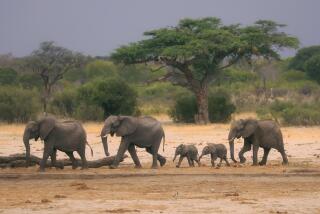Costa Rica Swamped by Tide of Eco-Tourism
- Share via
SAN JOSE, Costa Rica — The breathtaking forests and beaches of Manuel Antonio National Park contrast with the urban sprawl that has sprung up all around it to cater to the 200,000 tourists drawn to this Pacific coast paradise each year.
The natural treasures of this small Central American nation attract 1 million visitors a year. The $1-billion tourism business is the No. 1 income earner for the country, surpassing coffee and banana exports.
Thousands of plant and animal species are protected in 137 zones, covering 25% of the country. Costa Rica has at least 33 national parks and reserves.
But only 56% of those lands belong to the state. The government faces buying the remaining 44% from the hundreds of people, many farmers, who resided on the lands long before they were declared national parks.
The government plans to earmark $55 million to pay some of those people, who have been banned from working their lands.
But that represents only a fraction of the estimated $592 million owed to the property owners.
Manuel Antonio, one of the smallest parks with 1,577 acres, represents one of the most serious cases; nearly half the park is still in private hands. The government owes nearly $1 million to property owners.
At the Arenal Volcano national park, one of the country’s principal tourist attractions, the government still owes $6 million.
“Costa Rica’s commitment to its natural resources is serious, but it requires money,” said Second Vice President Elizabeth Odio Benito, who is also the environment minister.
Yet it’s unlikely the government will be able to pay off its ecological debt.
“A country so small that is dependent upon such big international markets can’t,” she said.
Costa Rica is seeking help from ecological organizations such as the Nature Conservancy, which will provide funds to pay for part of Cahuita National Park on the Carribbean coast.
It also is considering what is known as “oxygen sales,” a global market established by the World Bank that allows countries to trade carbon-emission credits to finance projects aimed at reducing greenhouse gas emissions in developing countries.
The Prototype Carbon Fund participants receive emissions credits based on the size of gas emission cuts achieved through the projects they finance.
The World Bank acts as a broker by helping to negotiate a price considered reasonable to both buyers and sellers of the credits that can be used to meet international climate control obligations.
Under the “oxygen sales” pilot project, Costa Rica sold close to $3.5 million in credits, and Odio expressed hope that the program would be officially adopted during a U.N.-sponsored conference on climate change Nov. 13-24 in The Hague. About 150 nations are expected to send representatives to the meeting, which will be chaired by the Netherlands.
But Costa Rica’s tourism industry is not the only business threatening the protected zones. The parks are also plagued by illegal logging and poaching.
The red macaw, a beautiful, exotic bird, is hunted by poor farmers who can sell them for as much as $225 apiece. Abroad, the bird can fetch as much as $5,000.
Although tourism has not failed in Costa Rica, Manuel Antonio represents a glitch in the model. The thousands of people who visit the park each year are taxing its infrastructure, highlighting the price of such success.
Park administrators this year limited the park to 600 visitors daily, increased the entrance fees and closed the park on Mondays.
But “none of this is in line with the international image that the country is selling,” said Jose Antonio Salazar, the park’s director, who has worked for the Environment Ministry for 12 years.
“What we are seeing here is overwhelming mass tourism, and it’s not sustainable,” he said. “The park is being besieged by buildings. There are no buffer zones left.”
Salazar said sewage from the 140 hotels winds up in the ocean.
And more hotels are expected.
Spanish company Marinas Canarias has started building a 100-room hotel next to the park.
“Development is both good and bad,” said Balbino Alegre, a representative of the firm.
More to Read
Sign up for Essential California
The most important California stories and recommendations in your inbox every morning.
You may occasionally receive promotional content from the Los Angeles Times.










